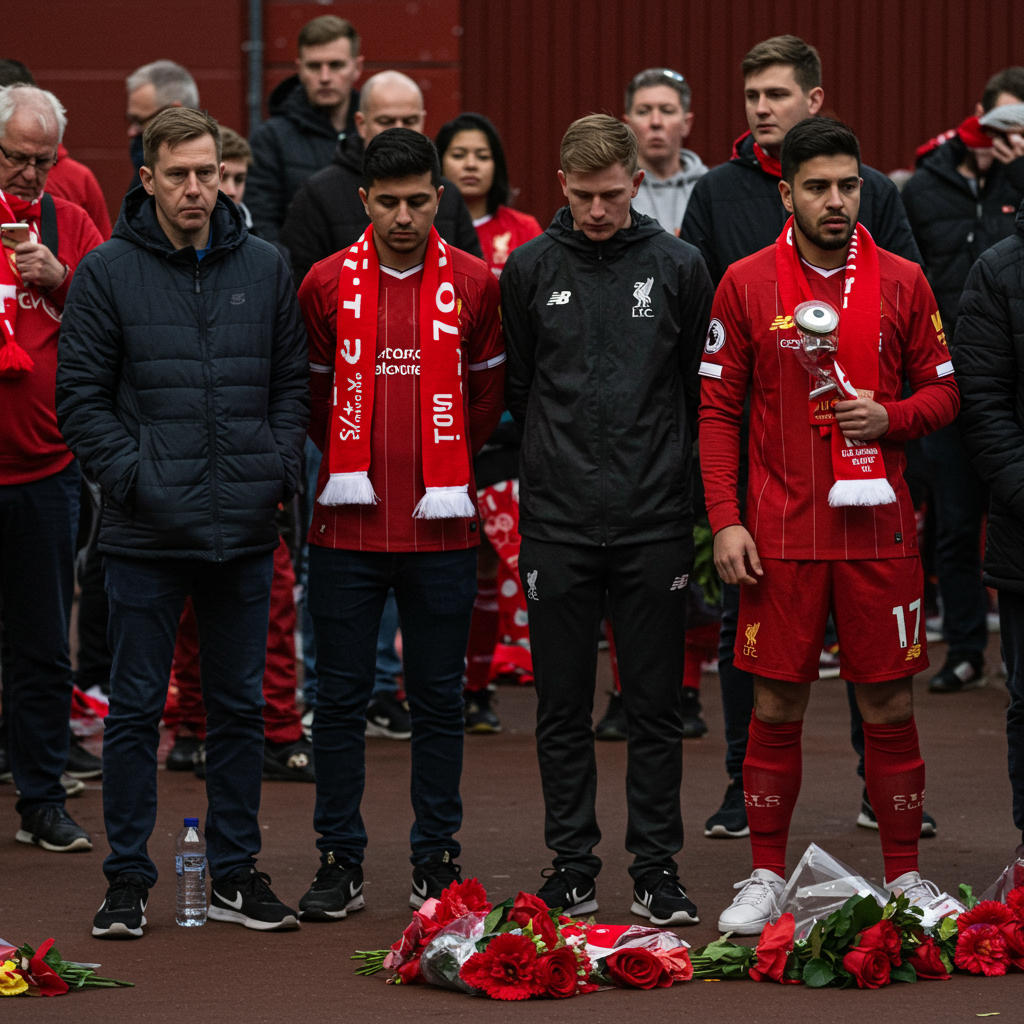Outside Anfield, the home of liverpool Football Club, supporters recently gathered in quiet reflection. They came to pay their respects to Diogo Jota, the gifted Portuguese forward whose life was tragically cut short. The scenes mirrored a city and a fanbase grappling with profound loss, remembering a player whose infectious spirit and relentless determination seemed to embody the very essence of Liverpool.
Many fans will forever hold one particular performance in their memory. In October 2022, against a Manchester City side destined for a historic treble, Liverpool faced a significant test during a patch of difficult form. Just weeks before the 2022 men’s World Cup, a tournament Jota openly described as a dream, some players might have understandably held back to avoid injury. This was not Diogo jota’s way.
Diogo Jota’s Unyielding Spirit on the Pitch
For a full 100 minutes in that crucial match, Jota battled without finding the net or providing an assist. Yet, his impact was immense. He relentlessly chased down the ball, winning possession back time and again through sheer effort and tenacity. Liverpool secured a vital 1-0 victory, a result earned through grit as much as skill. Tragically, in the dying moments of that tireless display, Jota sustained an injury that forced him to miss the World Cup, crushing a long-held dream.
The calf injury suffered against Manchester City sidelined him for four months. With the next World Cup cycle approaching, Jota, at 28, would almost certainly have earned another opportunity to represent Portugal on the world stage in 2026. That chance, alongside the deeply important experience of life as a young husband and father, was cruelly taken away. The news of his death, alongside his brother André Silva, following a car crash in Spain, sent shockwaves through the football world and the city he had made his home.
Hunger, Bravery, and the Liverpool Connection
His willingness to fight for every ball defined him. Neil Atkinson, CEO and host of The Anfield Wrap, captured this perfectly, describing Jota’s game as “full of this sort of scampering energy.” He added, “He would hunt the ball down aggressively, and he’d hunt space down aggressively.” While possessing clear technical gifts, Jota’s extraordinary work rate and desire were what truly captivated the Anfield faithful. This explains why his popular song was a constant soundtrack at games.
Atkinson also noted Jota’s “sense of mischief” in the way he scored his goals, an element that further endeared him to supporters. This blend of relentless effort and playful instinct resonated deeply on Merseyside. Jota himself articulated his philosophy, stating in a video released by the club, “As a fan – I was a fan myself – you want to see a player fighting for the club, for the badge that they both love.”
This tenacity wasn’t confined to the pitch. As a young player striving for minutes at European giant Atlético Madrid, Jota made a bold decision. He chose to join Wolverhampton Wanderers when they were in the Championship, English football’s second tier. This bravery paid off handsomely. He quickly became a standout player, instrumental in Wolves’ promotion and subsequent success, before earning his move to Liverpool in 2020.
A City Forged in Fight: Liverpool’s Resilience
It was at Liverpool that Jota seemed to find a particular affinity, connecting with a city that, much like his own career path, has frequently had to fight against adversity. The city’s history is marked by moments where it has had to stand strong against powerful forces.
In 1981, following riots spurred by tensions between the community and police, then-Prime Minister Margaret Thatcher’s finance minister, Geoffrey Howe, reportedly suggested a policy of “managed decline” for Liverpool. Spending public money, he argued, would be like “trying to make water flow uphill.” The city was essentially told it was beyond help, a narrative that required immense internal strength to overcome.
Eight years later, the Hillsborough disaster tragically claimed 97 lives at an FA Cup semifinal. In the immediate aftermath, parts of the media and even local police wrongly blamed Liverpool fans. The fight for justice by the victims’ families was long and arduous, lasting decades. It wasn’t until 2016 that an inquest finally ruled those who died were unlawfully killed and definitively cleared fans of any blame. These events solidified Liverpool’s identity as a place that fights for truth and justice.
Finding Strength Together: Community Spirit
The city has endured more recent tragedies too. Just weeks before Jota’s passing, a car incident during a parade celebrating the club’s Premier League title win injured dozens, including children. Through each challenge, Liverpool’s response has been consistent: unity. As Neil Atkinson put it, “The only way to get through this is to get through it together.”
This powerful sense of collective spirit was echoed by Liverpool fan Sally, speaking outside Anfield. “You stick together because that’s the only way it’s going to work,” she explained, emphasizing the deep-rooted community bond. She highlighted that this unity transcends footballing rivalries, noting, “It’s not just Liverpool, it’s Everton as well. Rivalries aside, times like this everyone comes together. It doesn’t matter who you support.” This was visually evident among the sea of tributes left at Anfield, where scarves and messages from rival Everton fans were respectfully placed alongside those from Reds.
Supporter Simon Walker expressed no surprise at the outpouring of grief and tribute, stating, “This is how this club and this city operates.” For Jota, who grew up 886 miles away from Merseyside, this acceptance meant finding a home away from home.
More Than a Footballer: A Relatable Figure
His connection extended beyond the pitch and into the fabric of local life. Tributes from former teammates highlighted his surprising enjoyment of quintessential British pastimes like darts and horse racing, even affectionately dubbing him “Diogo MacJota.”
Sally noted how relatable Jota felt to the fans. “You could relate to him,” she said. “You could tell he was a down-to-earth fella. He was very humble. He wasn’t showy-offy. He was just very much a family man.” This grounded nature resonated deeply in a city that values authenticity and community above ostentation. “I think that’s what relates everyone in the city to him,” Sally concluded, “because we’re all like a family.”
During his five years at the club, Diogo Jota scored 65 goals, often crucial ones, delivered with that characteristic blend of skill and fight. While the pain felt by his family – his wife and three children – and his closest friends is immeasurable, the widespread grief among Liverpool fans is a powerful testament to the bond he forged. His spirit and tenacity made him a beloved son of Liverpool, a city that recognized and embraced his fighting heart.
Frequently Asked Questions
What kind of player was Diogo Jota known as at Liverpool?
Diogo Jota was celebrated for his tireless work ethic, tenacity, and “scampering energy” on the pitch. While technically gifted, his willingness to aggressively hunt down the ball and fight for every possession was a defining characteristic that deeply resonated with Liverpool fans, earning him immense popularity.
How did Diogo Jota’s playing style connect with the city of Liverpool?
Jota’s individual fighting spirit was seen as mirroring the collective resilience and fighting history of the city of Liverpool. The city has a history of overcoming adversity and standing together, and Jota’s determination on the pitch embodied this spirit, making him feel like a natural fit and a true ‘son’ of the city.
What historical events are mentioned as shaping Liverpool’s resilient spirit?
The article references key historical events that have shaped Liverpool’s identity as a city that fights. These include the proposed policy of “managed decline” in 1981, the lengthy fight for justice following the Hillsborough disaster in 1989, and more recent incidents where the community has come together in the face of tragedy.




